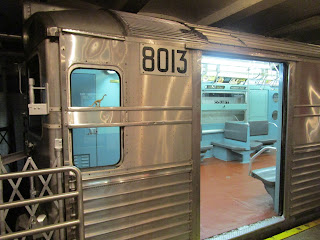 |
| Photo credit Danielle Bowman |
 Jacob and I, not expecting any connection to be made to our walk, got the wild idea to go down to the transit museum in Brooklyn. This is what happens when you start spending time with a history major. When we first walked up to it, all we could do was wonder why the transit museum didn't have a transit station right next to it.
Jacob and I, not expecting any connection to be made to our walk, got the wild idea to go down to the transit museum in Brooklyn. This is what happens when you start spending time with a history major. When we first walked up to it, all we could do was wonder why the transit museum didn't have a transit station right next to it.Then we looked down and realized that it was because the museum was actually a re-purposed metro station itself.
This isn't always the reason for there to be or not to be a metro station in a given space, though. Actually, the entire city is limited by rocks that started forming over 550 million years ago. Sediments (dirt!) deposited were hardened millions of years later into a harder rock, called schist, that makes up the boulders in central park and the bedrock underneath the city. Another continent ran into ours, pressing the sedimentary rock until it became more solid. It is extremely hard to cut through, and it was only more recently that this could be done with machines. Machines or handtools, they dulled easily, which posed challenges to the workers.
 This rock, at least, is stable because its so hard, so when it can be cut through, the tunnels are pretty stable.
This rock, at least, is stable because its so hard, so when it can be cut through, the tunnels are pretty stable. It isn't the only kind of rock present, though. formations that formed later aren't as hard, and have a habit of crumbling. This was extremely dangerous when the tunnels were initially being dug, especially when the walls caved in below the level of the rivers. Since then, they've been stabilized, but it makes constructing anything in them extremely dangerous.
It isn't the only kind of rock present, though. formations that formed later aren't as hard, and have a habit of crumbling. This was extremely dangerous when the tunnels were initially being dug, especially when the walls caved in below the level of the rivers. Since then, they've been stabilized, but it makes constructing anything in them extremely dangerous. To help with this, geologists and engineers took core samples so that they could plan ahead for the problems that they could potentially face, and know what they were going to be digging through in that area.
To help with this, geologists and engineers took core samples so that they could plan ahead for the problems that they could potentially face, and know what they were going to be digging through in that area.This isn't the only way that the past shaped the present. The skyline is also shaped by it. The height of the buildings is actually determined by the depth of the bed rock. Its what determined New York Cities unique skyline; buildings can only be built so tall when the foundation's depth are limited by how deep construction workers can dig before hitting the bedrock. You can actually predict the geology below based on the height of the buildings on Manhattan.
It makes for an interesting story, dating back to just before the first vertebrates appeared in the fossil record. As a result, it doesn't involve the dinosaurs, or any other animal to leave behind a fossil. I haven't heard anything about plants being found in the tunnels, either. So just to include some fossils, there's a dinosaur hiding in this antiquated metro card that was in the museum. Find him!!

No comments:
Post a Comment